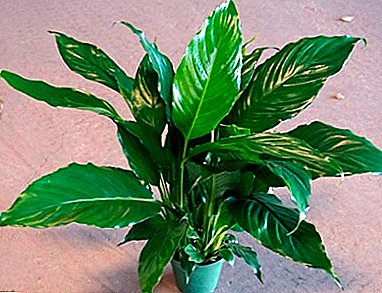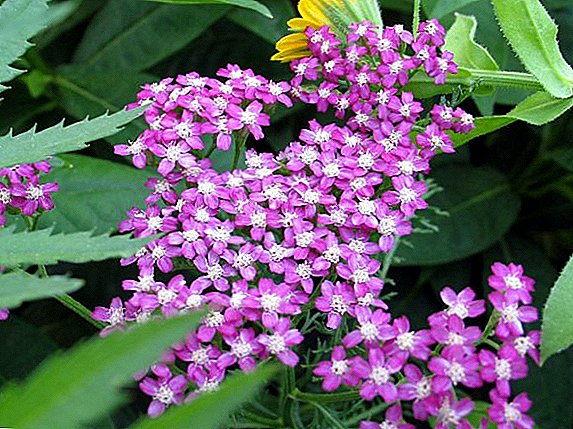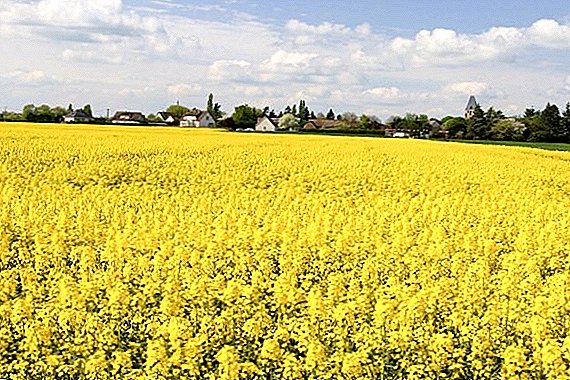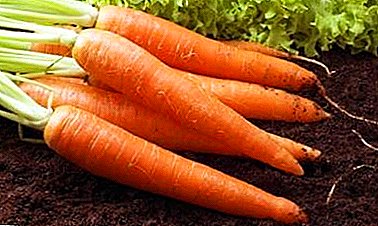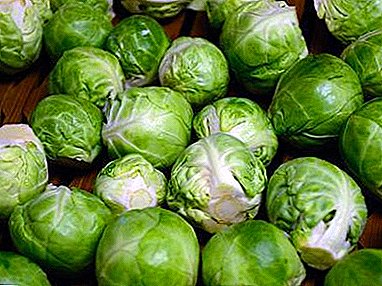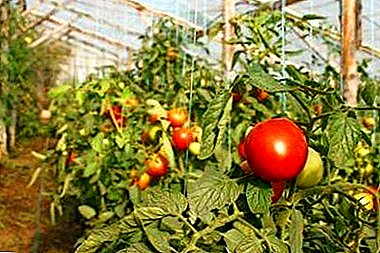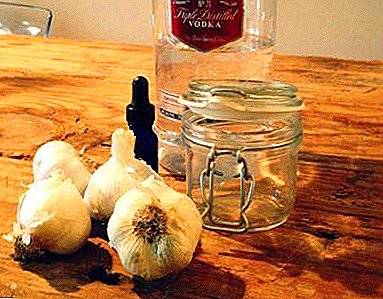 Each gardener empirically, planting different varieties, finds his favorite tomatoes. The variety with the warm name "Red cheeks" many of you will certainly appreciate for its early, abundant, fleshy and tasty fruits. This variety was obtained by Russian scientists and breeders and is intended for both greenhouse conditions and for cultivation in open ground.
Each gardener empirically, planting different varieties, finds his favorite tomatoes. The variety with the warm name "Red cheeks" many of you will certainly appreciate for its early, abundant, fleshy and tasty fruits. This variety was obtained by Russian scientists and breeders and is intended for both greenhouse conditions and for cultivation in open ground.
Variety description
Tomato "Red cheeks" is a hybrid variety of the first generation (F1), that is, the seeds collected from its fruit will not give quality offspring, since the positive characteristics of the hybrid will "fall apart" into parental forms.  The plant of this variety is stunted (about 1 meter on average), not standard, determinant (leave about 6-8 brushes) and contains the point of end of growth. The rhizome of tomatoes - strong, branched, diverging by almost 1 meter. The stem of the plant is strong, persistent, multi-leaved, with several brushes.
The plant of this variety is stunted (about 1 meter on average), not standard, determinant (leave about 6-8 brushes) and contains the point of end of growth. The rhizome of tomatoes - strong, branched, diverging by almost 1 meter. The stem of the plant is strong, persistent, multi-leaved, with several brushes.
To hybrid can be attributed such varieties of tomatoes as: "Kate", "Slot f1", "Bokele F1", "Star of Siberia", "Blagovest", "Red Guard F1", "Lyubasha F1", "Summer Garden", "Semko -Sinbad "," Irina f1 "," Verlioka "," Bokele F1 "," Spasskaya Tower F1 "," Torbay F1 "," Red Red "," Pink Paradise "," Pink Unicum "," Openwork F1 "," Petrusha gardener, Pink Bush, Monomakh's Cap, Big Mommy, Explosion, Raspberry Miracle and Masha F1 Doll.
Leaf - medium, wrinkled, dark green, "potato", growing in pairs. The inflorescence is simple, is laid approximately above the ninth leaf and goes through every two leaves. One inflorescence gives up to ten fruits.
The advantages of the variety:
- early maturation;
- high yield;
- universality of use;
- good taste and commercial quality;
- resistance to diseases and pests;
- good transportability and storage;
- adaptation to cold and heat.

Fruit characteristics and yield
Variety refers to the early ripening and gives its fruits 85-100 days after planting. Tomato bushes are distinguished by a large number of crops - up to nine kilograms per square meter.
Characteristic of fruits:
- size - medium;
- average weight - 100 g;
- shape - rounded, low-ridge;
- the skin is smooth, thin;
- color - deep red;
- taste - tender, sour.
Did you know? One glass of tomato juice contains half the daily norm of ascorbic acid necessary to support the body's defenses. And the high content of serotonin in it - the hormone of happiness - allows you to maintain a good mood even on the most dank and overcast day.
Selection of seedlings
Usually, tomato seedlings are purchased in late May - early June. Good seedlings of this variety should have 7-8 leaves and a clearly visible flower brush. It should have a strong, but not excessively thick stem and live, green lower leaves.  It should not be any damage and especially mold. It is not necessary to take the seedlings from the boxes with a very close fit, because when transplanting it can damage the roots. The plant is likely to take root, but will spend extra time and effort on restoring the root system. If possible, it is best to purchase seedlings in popular local nurseries.
It should not be any damage and especially mold. It is not necessary to take the seedlings from the boxes with a very close fit, because when transplanting it can damage the roots. The plant is likely to take root, but will spend extra time and effort on restoring the root system. If possible, it is best to purchase seedlings in popular local nurseries.
Find out also about when you can sow tomatoes on seedlings and how to properly seed tomatoes in open ground.
Private sellers often do not comply with the technology of growing plants, and together with the seedlings you can bring traditional diseases of tomatoes to your site. In addition, there is no guarantee that you will purchase exactly the desired grade.
Growing conditions
The soil for tomatoes should be highly fertile, low acidity, normal humidity and high oxygen saturation. Under greenhouse conditions, seedlings are planted in May at the age of about 65 days, and it can be planted in open ground in another couple of weeks. Then the surrounding air is already warm enough for planting, but for the first time it is necessary to provide shelter from the cold of the night. For tomatoes, choose a well-lit area without direct sunlight.
Important! According to reviews of vegetable growers, the variety "Red cheeks" bears fruits well in many regions - the middle lane, the Moscow region and the southern territories. And the cold summer is not a hindrance to the harvest of a good harvest.
Seedlings are planted in a staggered manner at a distance of approximately 40 cm from each other with a row spacing of at least 50 cm. Watering should be done under the root as the soil dries. Watering is done in the morning or evening hours, the next day the soil is loosened.
Seed preparation and planting
Sowing seeds for seedlings produced in early spring - in March. Before planting, tomato seeds must be disinfected in a solution of potassium permanganate and rinsed with clean water. You can also treat them with growth promoters to accelerate seedlings and improve development. You can buy soil for growing seedlings of tomatoes in a specialty store.  If the soil is taken from the site, you must first disinfect it and steam it. Seeds are planted in boxes or other containers in a moist soil to a depth of 2-3 cm, covered with polyethylene, which is removed only after germination.
If the soil is taken from the site, you must first disinfect it and steam it. Seeds are planted in boxes or other containers in a moist soil to a depth of 2-3 cm, covered with polyethylene, which is removed only after germination.
Important! Tomato "Red cheeks" refers to the hybrid varieties, so its seeds can not be called cheap, and the plants grow strong, powerful and abundantly fruiting.
Maintenance and care
The seedling should be in a room with a temperature not lower than +21 degrees Celsius, without drafts and with a constant source of natural or artificial lighting. It needs to be watered regularly and gently loosen the soil. Water should be warm water and not too often. Pickling seedlings produced after the formation of the second leaf. A couple of weeks before disembarking to a permanent place, it is necessary to harden the plants.  About once every 10 days you should feed the tomatoes with mineral fertilizers and not forget about loosening the soil and mulching, which will preserve the required soil moisture. Beefing is necessarily carried out, this removes the lower leaves of the plant and excess shoots up to 3-4 cm. Tomatoes are necessarily tied up on trellis or pegs, while it is better to use synthetic materials so as not to provoke rotting of the stem.
About once every 10 days you should feed the tomatoes with mineral fertilizers and not forget about loosening the soil and mulching, which will preserve the required soil moisture. Beefing is necessarily carried out, this removes the lower leaves of the plant and excess shoots up to 3-4 cm. Tomatoes are necessarily tied up on trellis or pegs, while it is better to use synthetic materials so as not to provoke rotting of the stem.
Did you know? For a long time, the fruits of tomatoes were considered poisonous, and the plant was used only for decorative purposes. They began to gain their popularity in the Americas after retired military Robert Gibbon Johnson ate a small bucket of tomatoes in public in 1822 sitting on the steps of the courthouse in Salem, New Jersey. The amazed spectators discovered that the colonel was completely alive and well.
Disease and pest prevention
The variety "Red cheeks" is characterized by sufficient resistance to the most common diseases of tomatoes - late blight, mosaic, powdery mildew, as well as to pests - aphids and a bear. However, as a prevention should:
- dig deep soil before planting tomatoes;
- use healthy planting material;
- do not plant plants too close to each other;
- immediately remove the first affected plants;
- when watering, try to prevent water from falling on the leaves;
- process plants with a 1% solution of Bordeaux mixture and anti-fungal drugs;
- remove plant residues from the site.

Harvesting and storage
Tomatoes of this variety are fruits with satisfactory storage. They reach their full ripeness on the 85-100th day after planting (approximately in July), but you can start removing them from the bush in a slightly reddened or brown condition. Such fruits ripen perfectly after a few days at home on the windowsill and even just on the table, and their taste will not decrease at all. With the threat of a cold snap, it is better not to expect full ripeness of the fruit, and remove them from the bushes.
Picking tomatoes depends on how and when they will be used. Reached full ripeness fruits are stored no more than 5-7 days, and they must be used fairly quickly. These tomatoes are well suited for fresh consumption, juice or pasta. Tomatoes of primary and secondary ripeness can be stored for about 10 days, they are well suited for transportation and long-term storage.
Learn how and where to store tomatoes.
For which, intact, healthy and dry fruits fit tightly into a wooden box. The box is placed in a cool and ventilated room, and in these conditions, tomatoes can be well preserved for up to two months. Milk tomatoes may lie especially long. In this case, the bottom of the box must be covered with straw, and the fruit carefully wrapped in paper. Such tomatoes should be stored in the cellar or on a closed balcony without heating.  When released into a warm room, they will quickly mature and will be ready to eat. Having grown and harvested a wonderful variety of "Red Cheeks", you can please your loved ones with a delicious and fragrant tomato salad even on New Year's holidays!
When released into a warm room, they will quickly mature and will be ready to eat. Having grown and harvested a wonderful variety of "Red Cheeks", you can please your loved ones with a delicious and fragrant tomato salad even on New Year's holidays!


